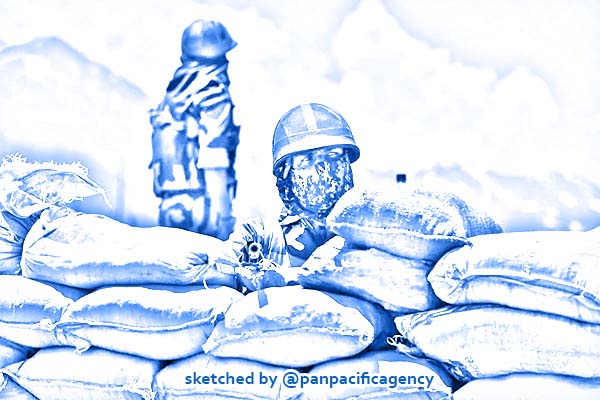[Analytics] India-China border standoff: Eight months on

Indian soldiers guard a highway leading to the Ladakh region. Photo: DPA. Sketched by the Pan Pacific Agency.
The India-China border stand off began in May last year, when the Chinese came in 8 km between Finger 8 and Finger 4 on the North bank of Pangong Tso. The Indian Army claims Finger 8 to be the Line of Actual Control (LAC) while the Chinese, in a clear alteration of status quo, have been camping at Finger 4 and have set up fortifications between Finger 5 and 8, India Today reported.
HOW IT STARTED?
The stand off escalated on June 15, 2020, when Indian and Chinese troops clashed in Galwan Valley near Patrol Point 14, resulting in 20 Indian soldiers and an undisclosed number of Chinese troops being killed. In early July, following an agreement at Corp Commander-level meet, China completed the withdrawal of its troops from face-off sites in Gogra and Hot Springs in eastern Ladakh.
In a surprise visit to Ladakh in July, Prime Minister Narendra Modi, in a clear and strong message to China, said the era of expansionism was over and India’s enemies had seen the “fire and fury” of its armed forces.
OCCUPYING STRATEGIC HEIGHTS
In late August, Indian Army special forces, including ethnic Tibetan fighters, took the Chinese by surprise to occupy strategic heights south of the Pangong Tso lake, overlooking Chinese positions.
On August 31, there was a brief exchange of “warning shots” when Chinese troops attempted to approach and evict Indian soldiers from strategic heights in south Pangong. This was the first recorded instance of firing on the India-China border since 1975.
In yet another skirmish on September 8, warning shots were fired between the troops of the two sides after China attempted to close in on Indian forward positions. Amid the crisis, External Affairs Minister Dr S Jaishankar held a meeting with his Chinese counterpart on the sidelines of the Shanghai Cooperation Organisation (SCO) on September 10 and reached a “five-point” consensus to ease the border tensions.
TALKS FAIL TO BREAK DEADLOCK
However, subsequent talks saw the two sides being unable to reach an understanding on details of the disengagement. Both the sides agreed to maintain dialogue and communication through military and diplomatic channels, and arrive at a “fair, reasonable and mutually acceptable solution” to disengagement as early as possible.
The Indian side has remained firm on its demand for an early and complete disengagement of troops by China from all the friction points in eastern Ladakh. The eighth round of military talks, which took place on November 6 at Chushul, saw some progress, with both sides discussing the disengagement of troops from specific friction points.
However, there has not been significant headway since then, with close to 1,00,000 soldiers from both sides deployed at extreme altitudes of over 12,000 feet.